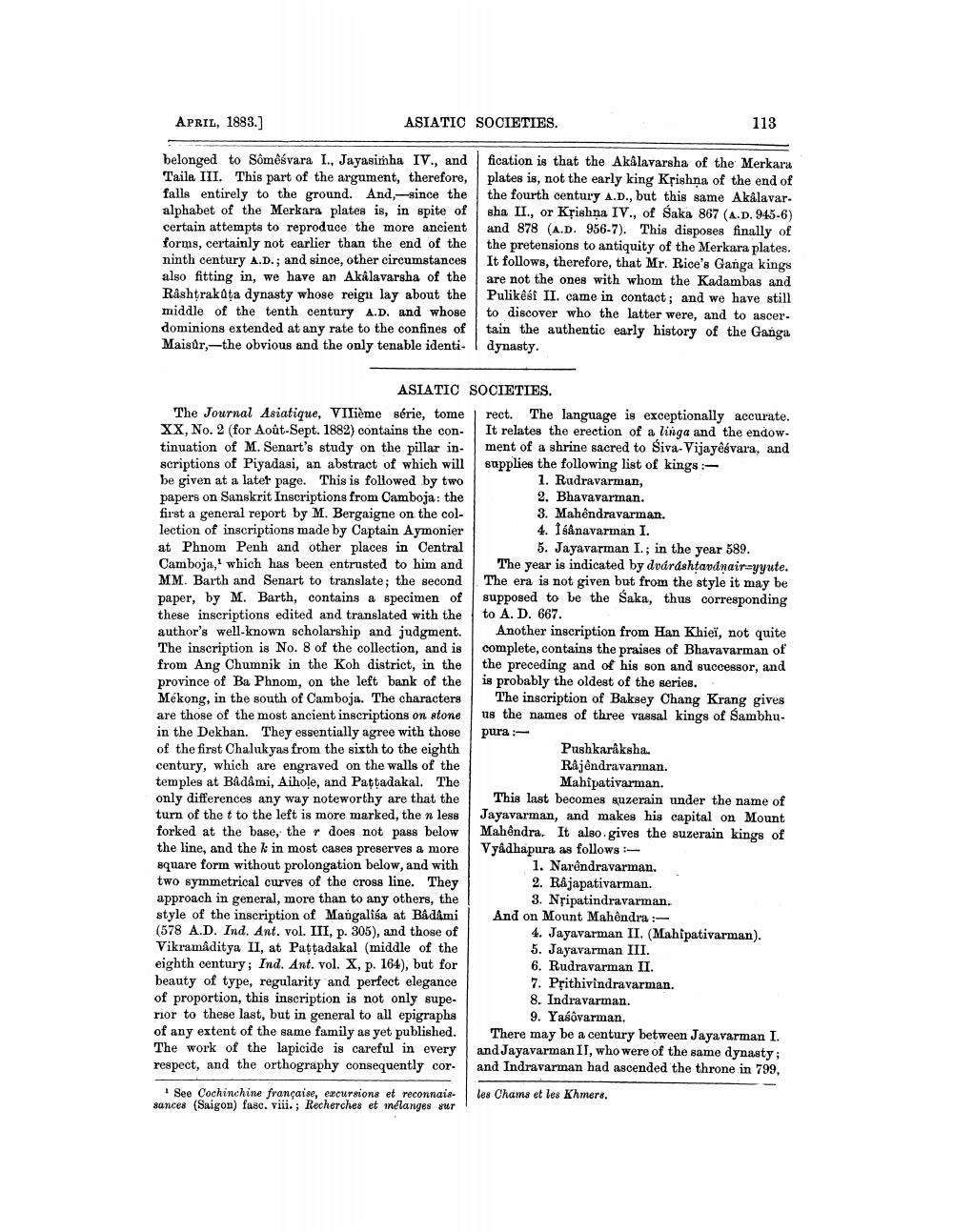________________
APRIL, 1883.]
ASIATIC SOCIETIES.
113
belonged to Sômêśvara I.. Jayasimha IV., and fication is that the Akalavarsha of the Merkara Taila III. This part of the argument, therefore, plates is, not the early king Krishna of the end of falls entirely to the ground. And,-since the the fourth century A.D., but this same Akalavar. alphabet of the Merkara plates is, in spite of sha II., or Krishna IV., of Saka 867 (A.D. 945-6) certain attempts to reproduce the more ancient and 878 (A.D. 956-7). This disposes finally of forms, certainly not earlier than the end of the the pretensions to antiquity of the Merkara plates. ninth century A.D.; and since, other circumstances It follows, therefore, that Mr. Rice's Ganga kings also fitting in, we have an Akalavarsha of the are not the ones with whom the Kadambas and Rashtrakåta dynasty whose reign lay about the Pulikesi II. came in contact; and we have still middle of the tenth century A.D. and whose to discover who the latter were, and to ascer. dominions extended at any rate to the confines oftain the authentic early history of the Ganga Maisur,-the obvious and the only tenable identi. I dynasty.
ASIATIC SOCIETIES. The Journal Asiatique, VIlième série, tome rect. The language is exceptionally accurate. XX, No. 2 (for Août Sept. 1882) contains the con- It relates the erection of a linga and the endow. tinuation of M. Senart's study on the pillar in- ment of a shrine sacred to Siva-Vijayêsvara, and scriptions of Piyadasi, an abstract of which will supplies the following list of kings :be given at a latet page. This is followed by two
1. Rudravarman, papers on Sanskrit Inscriptions from Camboja: the
2. Bhavavarman. first a general report by M. Bergaigne on the col
3. Mahendravarman. lection of inscriptions made by Captain Aymonier
4. I sånavarman I. at Phnom Penh and other places in Central
5. Jayavarman I.; in the year 589. Camboja,' which has been entrusted to him and The year is indicated by dvárdshtavdnairayyute. MM. Barth and Senart to translate; the second The era is not given but from the style it may be paper, by M. Barth, contains a specimen of supposed to be the Saka, thus corresponding these inscriptions edited and translated with the to A. D. 667. author's well-known scholarship and judgment. Another inscription from Han Khieï, not quite The inscription is No. 8 of the collection, and is complete, contains the praises of Bhavavarman of from Ang Chumnik in the Koh district, in the the preceding and of his son and successor, and province of Ba Phnom, on the left bank of the is probably the oldest of the series. Mékong, in the south of Camboja. The characters The inscription of Baksey Chang Krang gives are those of the most ancient inscriptions on stone us the names of three vassal kings of Sambhuin the Dekhan. They essentially agree with those pura :of the first Chalukyas from the sixth to the eighth
Pushkaraksha century, which are engraved on the walls of the
Rajendravarman. temples at Badâmi, Aihole, and Pattadakal. The
Mahipativarman. only differences any way noteworthy are that the This last becomes suzerain under the name of turn of the t to the left is more marked, the n less Jayavarman, and makes his capital on Mount forked at the base, the r does not pass below Mahôndra. It also gives the suzerain kings of the line, and the k in most cases preserves a more Vyâdhapura as follows:square form without prolongation below, and with
1. Narendravarman. two symmetrical curves of the cross line. They
2. Rajapativarman. approach in general, more than to any others, the
3. Nripatindravarman. style of the inscription of Mangalisa at Bâdâmi And on Mount Mahendra :(578 A.D. Ind. Ant. vol. III, p. 305), and those of
4. Jayavarman II. (Mahipativarman). Vikramaditya II, at Pattadakal (middle of the
5. Jayavarman III. eighth century; Ind. Ant. vol. X, p. 164), but for
6. Rudravarman II. beauty of type, regularity and perfect elegance
7. Prithivindravarman. of proportion, this inscription is not only supe
8. Indravarman. rior to these last, but in general to all epigraphs
9. Yasovarman. of any extent of the same family as yet published. There may be a century between Jayavarman I. The work of the lapicide is careful in every and Jayavarman IT, who were of the same dynasty; respect, and the orthography consequently cor. and Indravarman had ascended the throne in 799,
See Cochinchine française, excursions et reconnais sances (Saigon) fasc. viii.; Recherches et inélanges sur
les Chams et les Khmers.




